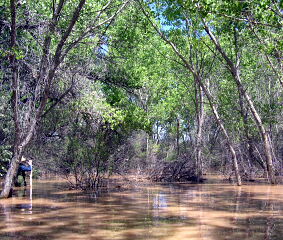Current Projects
Ecological
impacts
of the invasive New Zealand mud snail, (Potomopyrgus antipodarum) in rivers
of Grand Teton and Yellowstone National Parks
The freshwater snail, Potomopyrgus antipodarum, is
native
to New Zealand and has been introduced in Europe, Australia, and
North America. Since it was first detected in Yellowstone National Park
in 1994, it has rapidly spread within and near the park. New Zealand
mud snails are found in
extremely high densities in geothermal spring streams (20,000-500,000
snails/m2) and consume up to 75% of
gross primary production and excrete two-thirds of the ammonium demand
in these streams (Hall, Tank and Dybdahl 2003). While most studies have
focused on carbon and nitrogen dynamics of mud snails, I am especially
interested in how these snails mediate phosphorus cycling in these
streams. Because mud snails have high phosphorus demands and are
found in such high numbers relative to native biota, it is likely this
species is limited in phosphorus-poor environments. I am studying food
quality constraints of growth and reproduction in collboration with Dr.
Amy Krist at the University of Wyoming.
Ongoing Projects
Using
ecological stoichiometry and stable
isotopes to understand trophic relationships of organisms
Dissertation research
Ecological stoichiometry of riparian trees and arthropods: effects of flooding and exotic species along the Middle Rio Grande, NM
